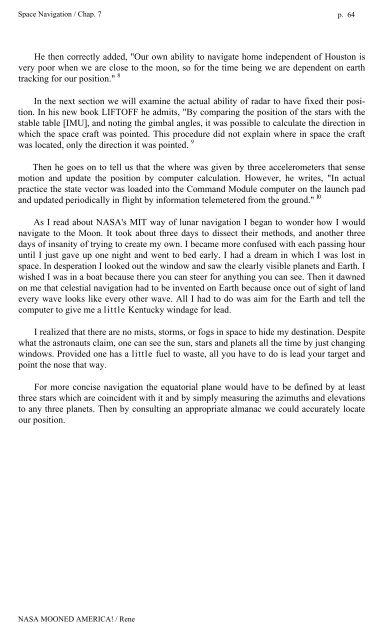Rene-NASA-Mooned-America
Rene-NASA-Mooned-America
Rene-NASA-Mooned-America
Create successful ePaper yourself
Turn your PDF publications into a flip-book with our unique Google optimized e-Paper software.
Space Navigation / Chap. 7 p. 64<br />
He then correctly added, "Our own ability to navigate home independent of Houston is<br />
very poor when we are close to the moon, so for the time being we are dependent on earth<br />
tracking for our position." 8<br />
In the next section we will examine the actual ability of radar to have fixed their position.<br />
In his new book LIFTOFF he admits, "By comparing the position of the stars with the<br />
stable table [IMU], and noting the gimbal angles, it was possible to calculate the direction in<br />
which the space craft was pointed. This procedure did not explain where in space the craft<br />
was located, only the direction it was pointed. 9<br />
Then he goes on to tell us that the where was given by three accelerometers that sense<br />
motion and update the position by computer calculation. However, he writes, "In actual<br />
practice the state vector was loaded into the Command Module computer on the launch pad<br />
and updated periodically in flight by information telemetered from the ground." I0<br />
As I read about <strong>NASA</strong>'s MIT way of lunar navigation I began to wonder how I would<br />
navigate to the Moon. It took about three days to dissect their methods, and another three<br />
days of insanity of trying to create my own. I became more confused with each passing hour<br />
until I just gave up one night and went to bed early. I had a dream in which I was lost in<br />
space. In desperation I looked out the window and saw the clearly visible planets and Earth. I<br />
wished I was in a boat because there you can steer for anything you can see. Then it dawned<br />
on me that celestial navigation had to be invented on Earth because once out of sight of land<br />
every wave looks like every other wave. All I had to do was aim for the Earth and tell the<br />
computer to give me a little Kentucky windage for lead.<br />
I realized that there are no mists, storms, or fogs in space to hide my destination. Despite<br />
what the astronauts claim, one can see the sun, stars and planets all the time by just changing<br />
windows. Provided one has a little fuel to waste, all you have to do is lead your target and<br />
point the nose that way.<br />
For more concise navigation the equatorial plane would have to be defined by at least<br />
three stars which are coincident with it and by simply measuring the azimuths and elevations<br />
to any three planets. Then by consulting an appropriate almanac we could accurately locate<br />
our position.<br />
<strong>NASA</strong> MOONED AMERICA! / <strong>Rene</strong>


